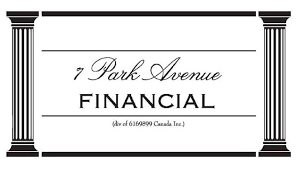|
Optimizing Cash Flow Through Asset Based Lending
The Business Lifeline: Exploring Benefits of Asset Based Lending
YOUR COMPANY IS LOOKING FOR A BUSINESS LINE OF CREDIT FINANCING
WHY AN ASSET-BASED LOAN MIGHT BE YOUR BEST SOLUTION!
You've arrived at the right address! Welcome to 7 Park Avenue Financial
Financing & Cash flow are the biggest issues facing businesses today
ARE YOU UNAWARE OR DISSATISFIED WITH YOUR CURRENT BUSINESS FINANCING OPTIONS?
CALL NOW - DIRECT LINE - 416 319 5769 - Let's talk or arrange a meeting to discuss your needs
EMAIL - sprokop@7parkavenuefinancial.com

Asset Based Lending offers a robust financial pathway for businesses to leverage their tangible assets for essential funding.
Unlock your company's potential with Asset Based Lending – the key to overcoming your financing hurdles!
7 Park Avenue Financial originates business financing solutions for Canadian Businesses – We offer ASSET BASED LENDING solutions that solve the issue of cash flow and working capital – Save time and focus on profits and business opportunities
SOLUTIONS FOR BUSINESS LINES OF CREDIT IN CANADA
INTRODUCTION
Canadian business owners and financial managers fully realize that based on their working capital and cash flow needs, a business line of credit is a necessity for the overall financing needs of the business.
Asset Based Lending (ABL) is a powerful business credit line solution for businesses seeking liquidity and who have sales revenues and tangible assets.
By leveraging these balance sheet assets as collateral, companies can secure the necessary funding, often overlooked by traditional banking / traditional financial institutions. Typical balance sheet assets include receivables, inventory, fixed assets and even commercial real estate as a pledged asset if owned by the company.
Asset-backed finance caters to firms with strong asset bases but also those encountering conventional credit challenges, thereby providing a lifeline to maintain day-to-day business operations and the ability to grow.
THE CRITICAL NEED FOR BUSINESS CREDIT
An asset finance strategy can sometimes be the best solution for your overall business financing needs. Clients we speak to have trouble differentiating this type of solution from a regular Canadian chartered bank line of credit.
ASSET-BASED CREDIT LINES VERSUS BANK CREDIT LINES
The difference is simply the overall focus of the financing – an asset-based line of credit focuses solely on the variety of different business assets you have – they include predominantly inventory, receivables, equipment, and in some cases, physical assets such as real estate - These determine facility limits and the maximum loan amount and asset lending values
FINANCING ACCOUNTS RECEIVABLE AND INVENTORIES
When you successfully set up an asset-based loan facility, you monetize these assets to their maximum and borrow against them as you need funds daily. Naturally, the main and most liquid assets in this type of financing tend to be receivables and inventory. Still, those other hard assets can nicely shore up an even higher credit facility for your firm.
ASSET-BASED LENDER OR A BANK?
So let’s get back to the difference between this type of facility, which some companies have never heard of, and a bank line revolving credit line facility. Your asset-based business line of credit, unlike the bank facility, focuses 99% on the value of the assets in your business.
The bottom line is that as those assets grow, you have unlimited working capital to grow! – And that’s a good thing. To be clear, interest rates are higher in asset-based lending, but they provide far more business capital than a company could achieve via traditional bank lending.
The credit limit grows automatically as your sales and assets grow! This is not a term loan structure, so there are no minimum monthly payments - your credit facility ... ' revolves '! Asset-based lenders place a minimal emphasis on the owner/owners' personal credit score and credit history of the owner/owners - it's all about sales and assets!
COLLATERAL VALUE MEANS MORE BORROWING POWER!
Another way of looking at this or explaining it more clearly is how these loans are set up and approved. Asset-based loans for a business line of credit in this asset finance strategy focus on collateral and value. If you have now or in the past secured a bank facility, on the other hand, you, of course, recognize the banks put a lot of emphasis on non-asset issues such as overall financial statement quality, external collateral, personal guarantee, etc.
DOES YOUR FIRM QUALIFY FOR BANK CREDIT, OR IS THE ' ABL ' SOLUTION THE BEST FOR YOUR FIRM
If you can demonstrate positive cash flow and cash flow from operations to a Canadian chartered bank, you can likely obtain a business line of credit at an excellent and lower interest rate and annual fees commensurate with your firm's overall credit quality.
On the other hand, asset finance is collateral-based – if you have A/R, inventory, and perhaps equipment and real estate, you can draw down daily against the value of those assets! That suits your overall needs. That is the main difference between these two types of financing.
NO RATIOS / COVENANTS / OUTSIDE COLLATERAL!
One other critical difference is that fewer covenants and ratio requirements are in place in an asset-based line of credit. So if your firm has ongoing liquid and fixed assets, you are in an excellent position to negotiate a business line of credit for an asset-based financing facility. This is not a lump sum amount of capital received on a one-time basis.
HOW DO ASSET-BASED CREDIT REVOLVERS WORK?
'How does this facility work daily?' is a question we always get from clients. You still, of course, do your banking at a bank or perhaps a credit union – but you supply on a regular (perhaps a weekly or monthly basis) what is known as a borrowing base certificate for your assets.
The asset-based lender then advances funds into your account, which you can use to finance your business. ABL lending allows you to use the same business bank account you have always used. Funds needed are deposited into that account.
Asset-based loans, or working capital facilities as we also like to call them, have different levels of pricing based on the overall facility size of the credit line and with whom you are financing the line - i.e. either a bank or a commercial finance company/asset-based lender. Naturally, in any line of credit, you only pay interest on what you use in the facility.
KEY TAKEAWAYS
Types of Assets as Collateral: Key assets include inventory, accounts receivable, equipment, and real estate. These assets back the loan, providing security to lenders and flexibility to borrowers.
Risk Management in ABL: Lenders closely monitor the collateral's value, ensuring it covers the loan amount, which helps manage risk and maintain financial stability.
ABL vs. Traditional Loans: Unlike conventional loans, ABL depends more on collateral value than on creditworthiness, making it accessible for businesses with strong assets but weaker credit.
Impact on Business Cash Flow: By providing immediate funding based on asset values, ABL enhances cash flow, crucial for operational and growth needs.
Benefits of ABL: This includes quicker loan approval, improved liquidity, and the ability to leverage assets without selling them, essential for sustained business operations.
CONCLUSION
Small businesses can't run and grow their business credit cards or merchant cash advance /short-term business loan & working capital loans for available credit.
Call 7 Park Avenue Financial, a credible, trusted, and experienced business financing advisor to determine if this type of working capital arrangement suits your firm.
Many Canadian businesses are moving to this facility to fund future growth and profits to pay back financing for their business needs.
FAQ: FREQUENTLY ASKED QUESTIONS / PEOPLE ALSO ASK / MORE INFORMATION
What do you need to know about a business line of credit?
For small businesses that want to pay vendors and employees on time, a business line of credit is the perfect solution. Essentially this type of loan allows you access capital which can then be used for day-to-day working capital needs or paying off other short-term financial necessities such as taxes owed or payroll before they come due. It’s efficient and essential in many cases - especially if cash flow may drop during certain times throughout the year.
A Business Line of Credit is an excellent option for any small business looking to grow their company without having too much risk weighing them down from slow periods where it might take some.
A business line of credit can help small businesses meet their day-to-day working capital and short-term financial necessities. It allows them to apply for borrowed funds today that they may need in the future. Many enterprises use a line of credit as part of an overall strategy for meeting long-term goals.
How does Asset Based Lending provide a solution for businesses with irregular cash flow?
By allowing businesses to borrow against their assets, ABL offers a flexible way to enhance cash flow despite seasonal or unpredictable revenue patterns.
What makes Asset Based Lending a preferable option for startups?
Startups often lack a lengthy credit history but may have valuable assets, which makes ABL a viable option for securing needed funds.
Which assets are commonly used as collateral in Asset Based Lending?
Receivables, inventory, equipment, and sometimes real estate are typical collateral in ABL, providing tangible security for loans.
How does Asset Based Lending differ from traditional bank loans?
ABL focuses on the value of your assets rather than creditworthiness, offering a more accessible funding source for many businesses.
What are the main benefits of Asset Based Lending for a company?
Quick access to funds, flexibility in asset management, and the potential for larger loan amounts based on asset value are key benefits.
What is the typical interest rate for an Asset Based Loan?
Interest rates vary but generally align with market conditions and the borrower's risk profile, often ranging from moderate to slightly higher than traditional loans.
Are there specific industries that benefit more from Asset Based Lending?
Industries with high levels of inventory or receivables, like manufacturing and wholesale, often find ABL particularly advantageous.
Can personal assets be used for Asset Based Lending in a business context?
Typically, ABL focuses on business assets, but personal assets may be considered in certain small business scenarios.
How quickly can a business access funds through Asset Based Lending?
Funding timelines can vary but often are faster than conventional loans, with some cases seeing funds within a few weeks of application.
What are the common challenges or pitfalls with Asset Based Lending?
Managing loan-to-value ratios and ensuring ongoing asset valuation can be challenging but are crucial for maintaining loan integrity and compliance.
What are the first steps to take when considering Asset Based Lending?
Assess your asset inventory and consult with a financial advisor to ensure ABL aligns with your financial strategy and goals.
How does ABL affect a company's balance sheet?
ABL can improve liquidity ratios by converting non-liquid assets into cash, potentially strengthening the balance sheet.
Is there regulatory oversight in Asset Based Lending?
Yes, ABL is regulated to ensure fair practices and to protect both lenders and borrowers, with specifics varying by jurisdiction.

' Canadian Business Financing With The Intelligent Use Of Experience '
STAN PROKOP
7 Park Avenue Financial/Copyright/2025

Stan Prokop is the founder of 7 Park Avenue Financial and a recognized expert on Canadian Business Financing. Since 2004 Stan has helped hundreds of small, medium and large organizations achieve the financing they need to survive and grow. He has decades of credit and lending experience working for firms such as Hewlett Packard / Cable & Wireless / Ashland Oil
|